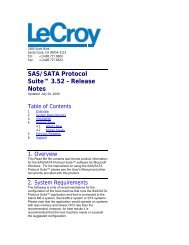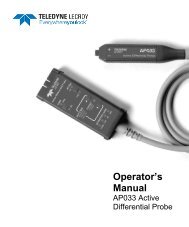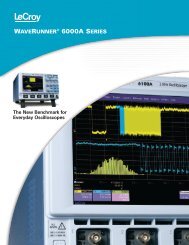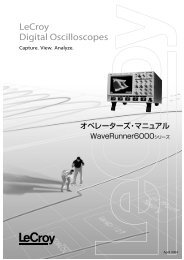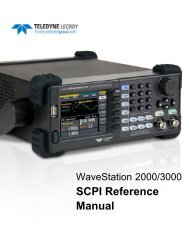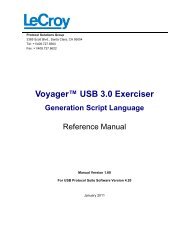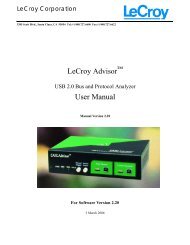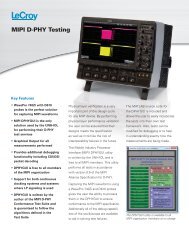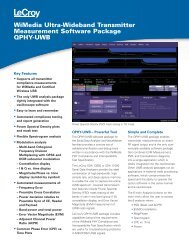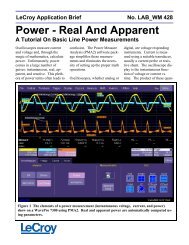LAB 740 - Frequency Response Measurements - Teledyne LeCroy
LAB 740 - Frequency Response Measurements - Teledyne LeCroy
LAB 740 - Frequency Response Measurements - Teledyne LeCroy
Create successful ePaper yourself
Turn your PDF publications into a flip-book with our unique Google optimized e-Paper software.
<strong>LeCroy</strong> Applications Brief No. L.A.B. <strong>740</strong><br />
<strong>Frequency</strong> <strong>Response</strong> <strong>Measurements</strong><br />
Derive <strong>Frequency</strong> <strong>Response</strong> From Step <strong>Response</strong><br />
Filters, amplifiers, and control<br />
systems are usually characterized<br />
by their frequency response<br />
functions. These functions are<br />
usually shown in graphical form<br />
as plots of log amplitude vs. log<br />
frequency called Bode plots.<br />
Oscilloscopes are primarily time<br />
domain measuring instruments.<br />
They represent acquired<br />
waveforms as a time series,<br />
plotting signal amplitude as a<br />
function of time. Utilizing the<br />
mathematical capabilities<br />
available in modern digital<br />
oscilloscopes it is possible to<br />
derive the frequency response<br />
function of a circuit based on the<br />
measured time response to a<br />
step function.<br />
Figure 1 – Transforming the measured step response of a filter<br />
into the frequency response.<br />
An example of this measurement<br />
and analysis is shown in figure 1.<br />
A 1 kHz square wave is applied<br />
to a low pass filter and the output<br />
of the filter is acquired and<br />
displayed in the top trace (Ch 3).<br />
The frequency response function<br />
is the Fourier transform of the<br />
circuits impulse response. The<br />
impulse response can be derived<br />
from the measured step response<br />
by differentiating the step<br />
response. This step is performed<br />
in trace A in figure 1.<br />
To increase the dynamic range of<br />
this measurement and improve<br />
signal/noise ratio the impulse<br />
response is averaged as shown in<br />
trace B.<br />
The Fast Fourier Transform<br />
(FFT) is used to convert the<br />
impulse response into the<br />
frequency response function.<br />
Trace C, not shown applies the<br />
FFT to trace B. Trace D, the<br />
FFT Average function, provides<br />
averaging in the frequency<br />
domain for further improvement<br />
in dynamic range. Note that<br />
number of points used in the<br />
calculations is user selectable. In<br />
this example the transform size<br />
is set to 1000 points yielding a<br />
500 point frequency spectrum.<br />
<strong>LeCroy</strong> oscilloscopes support<br />
FFT calculations with transform<br />
sizes of up to 4 Mpoints,<br />
dependent on the options<br />
installed.<br />
Trace D, is the frequency<br />
response function shown as a<br />
plot of log amplitude (power<br />
spectrum) vs. linear frequency.<br />
Relative time cursors have been<br />
setup to measure the 3 dB point<br />
of the low pass filter as 33.4<br />
MHz.<br />
This data can be converted into a<br />
classic Bode plot by saving the<br />
frequency spectrum to floppy<br />
disk in spreadsheet format and<br />
plotting it in Log-Log format<br />
using a spreadsheet, such as<br />
Microsoft Excel.
Figure 2 shows the data from<br />
trace D in figure 1, re-plotted<br />
Log – Log format using an Excel<br />
spreadsheet.<br />
<strong>LeCroy</strong> Applications Brief No. L.A.B. <strong>740</strong><br />
<strong>Frequency</strong> <strong>Response</strong> Function<br />
Amplitude dBm<br />
130<br />
120<br />
110<br />
100<br />
90<br />
80<br />
70<br />
60<br />
100000 1000000 10000000 100000000<br />
<strong>Frequency</strong> (Hz)<br />
Figure 2



